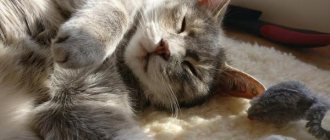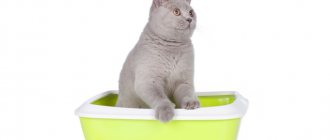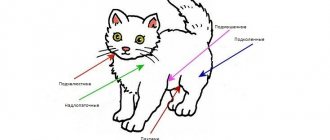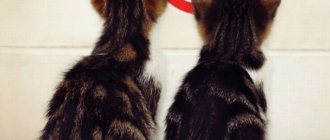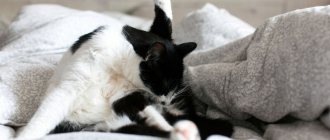One of the most common diseases of the digestive system in cats is colitis. Its development can be triggered by various factors, but the main thing is to provide timely assistance to the pet in order to avoid the development of serious consequences. To learn how to determine colitis in a cat and whether this disease can be treated, see below.
Read in this article:
Colitis - what is it? Forms of the disease: how does it occur in cats? Causes of colitis in cats Signs of inflammation Complications – why is the disease dangerous? How to determine colitis? Prognosis Treatment of colitis in cats Diet for inflammation of the large intestine Prevention of colitis: recommendations from a veterinarian
Forms of the disease: how does it occur in cats?
Acute colitis . Most often it is provoked by poor-quality food or a sharp change in diet (for example, a transition from natural food to industrial food). Symptoms of acute colitis increase very quickly - within 2-3 hours. There are bouts of vomiting, loss of appetite or complete refusal to eat, and a lethargic and painful state of the pet.
Chronic colitis . Often the causes of chronic colitis cannot be determined. Such an inflammatory process, the symptoms of which develop over a long period of time (for example, several days or even weeks), is called idiopathic. Treatment for chronic colitis usually includes a special diet high in fiber. The disease itself is long-lasting and difficult to treat.
The mechanism of development of diarrhea after a course of antibiotics
Antibiotic-associated diarrhea (AAD) develops as a result of the death of both pathogenic bacteria and beneficial microorganisms. An imbalance of microflora is called dysbiosis. According to statistics, the source of such digestive disorders can be up to ⅕ of the types of antibiotics used in medical practice. Typically, this phenomenon occurs as a result of taking broad-spectrum drugs.
Typically, this type of diarrhea does not have other symptoms, unlike food poisoning. The main symptoms of antibiotic poisoning include watery or loose stools, and less commonly, cramping abdominal pain. Most often, the intestinal condition returns to normal after 2-3 days.
In very rare cases, antibacterial therapy can cause colonization of the mucous membranes by pathogenic microorganisms - Clostridium difficile and Salmonella. They cause severe infections with persistent diarrhea, which increases the risk of dehydration and can lead to serious health consequences.
Antibiotic-associated diarrhea can occur with long-term use of suitable doses of the drug, and not necessarily in tablet form - injections can also lead to this result. However, poisoning can also occur due to an overdose. Each antibiotic has a toxic effect on different organs, so the category of the drug is taken into account. Common symptoms of overdose include the following:
- high body temperature (up to 39–40 ˚C);
- diarrhea;
- vomit;
- muscle pain;
- pain in the right hypochondrium;
- changes in blood pressure;
- tachycardia or bradycardia;
- joint pain;
- dizziness, etc.
With toxic damage to the liver, the following symptoms may appear: yellowness of the skin and sclera, itching of the skin, bloating, etc. With kidney damage, the volume of urine decreases significantly, and a strong feeling of thirst occurs. Poisoning with aminoglycosides leads to the appearance of signs of toxic otitis: acute pain in the ears, decreased hearing acuity, a feeling of congestion, etc. All conditions associated with an overdose of antibiotics require immediate treatment of poisoning . It is important to call an ambulance as soon as possible.
Causes of colitis in cats
The most common cause of colitis in cats is poor quality nutrition. Expired foods, foods from the human table (for example, smoked sausages, sausages, pates, fried, salty or spicy foods) - all this can lead to disruption of the functioning of the digestive system and the development of colitis.
Frequent overeating or lack of a balanced diet in combination with low-quality products can also provoke the development of pathogenic bacterial microflora in the cat’s body, nausea and vomiting, as well as an inflammatory process - colitis.
Other factors that trigger the development of ulcerative colitis in cats include:
- drinking raw water
- taking prohibited foods (for example, baked goods),
- invasive (parasitic) diseases,
- problems with metabolism in the animal’s body,
- dysbacteriosis (disturbance of microflora),
- damage to the intestinal walls (for example, from swallowing small foreign objects or bones).
Another reason that can lead to the development of colitis in pets is stress. They may be associated with a change in place of residence or the appearance of another pet in the house (for example, another cat).
Diagnostics
There is considerable controversy regarding the appropriate way to diagnose LPR.
Most patients are diagnosed clinically, based on symptoms associated with LPR.
During laryngoscopy (examination of the larynx), swelling and hyperemia (redness) of varying degrees are noted. However, the relatively weak correlation between symptoms and endoscopic findings argues against the use of endoscopic diagnostic methods.
The Reflux Symptom Score and Reflux Symptom Index are well suited for both diagnosis and monitoring response to therapy.
Daily Ph-metry with a dual sensor probe, despite its excellent sensitivity and specificity, is questioned, since the results of this diagnostic method often do not correlate with the severity of symptoms.
Another diagnostic option may be empirical PPI therapy.
Signs of inflammation
The first thing that indicates the development of colitis in a cat is acute and frequent diarrhea. Blood clots and mucus are present in the stool. Some cats experience pain during defecation, so they meow loudly. In some cases, animals try to stop defecating, which only provokes the development of constipation.
Other symptoms of colitis in cats:
- loss of appetite,
- bouts of vomiting,
- lethargic state
- apathy,
- weakness,
- refusal to play,
- plaintive meow,
- lack of response to any calls,
- pain when palpating the abdominal area.
With colitis, the condition of cats worsens sharply. In advanced cases, body temperature rises (we remind you that in normal conditions it is 38-39 °C), and the mucous membranes acquire a violet-bluish color. In acute colitis, if you do not contact a veterinarian in a timely manner, severe convulsions are possible.
First aid at home: how to relieve pain from an attack
A very important rule for providing first aid at home is not to administer painkillers to relieve spastic attacks unless prescribed by a specialist.
- You can numb the attack while waiting for a specialist to arrive by gently massaging your abdomen and applying a heating pad with ice to the sore spot.
- It is allowed to use adsorbent and carminative drugs when administered orally.
- If the condition is critical, the cat screams in pain, there is vomiting and diarrhea with blood, you must immediately inform a specialist about this, you can even by phone. Most often, in such a situation, the doctor recommends an injection of an anesthetic drug to avoid painful shock.
Complications – why is the disease dangerous?
If you do not respond to changes in your pet’s condition and do not seek veterinary help, colitis can lead to serious consequences - intoxication of the cat’s body. Toxins affect the functioning of all internal organs, including the liver and kidneys. The functioning of the gastrointestinal tract is disrupted, the pet completely refuses to eat, and the absorption of vitamins and nutrients worsens. All this leads to exhaustion, dehydration, and in severe cases, death.
To prevent complications, contact a veterinary clinic in a timely manner - doctors will examine your pet and prescribe effective treatment to fully restore the animal’s body!
How to determine colitis?
Only a veterinarian can make an accurate diagnosis. If you notice signs of inflammation or other changes in your cat's behavior, take her to a veterinary clinic immediately. We strongly do not recommend doing treatment yourself - this can lead to serious and irreversible consequences for the animal’s health.
To make an accurate diagnosis, the veterinarian palpates the abdominal area, interviews the cat’s owner, and also prescribes tests:
- Ultrasound of the abdominal cavity,
- stool analysis,
- general and clinical blood tests,
- biopsy,
- endoscopic examination of the large intestine.
The veterinarian not only makes a diagnosis, but also prescribes treatment taking into account the characteristics of the pet’s condition.
Intestinal parasites
Quite common in kittens. Roundworms and hookworms are the most common intestinal parasites and many kittens become infected with these worms soon after birth, either through the mother's milk or through contact with a contaminated environment. Other parasites such as tapeworms, coccidia and giardia may also be seen. To diagnose intestinal parasites, your veterinarian will examine a sample of your kitten's stool under a microscope and then prescribe a treatment regimen based on the type of parasite.
Treatment of colitis in cats
On the one hand, treatment of colitis is aimed at eliminating the cause that provoked the development of the disease (for example, helminths), and on the other, at restoring the animal’s digestive system. Various methods are used for this, including drug therapy and diet.
Drug therapy involves the use of various drugs (probiotics, anti-inflammatory and antimicrobial agents). Additionally, medications are prescribed that affect intestinal motility and restore its normal functioning.
Most often, treatment is carried out on an outpatient basis. If necessary, additional methods are used, one of which is anthelmintic treatment of the animal or surgery (prescribed if elimination of ulcerative colitis is required).
Additional treatment methods also include infusion therapy (drip), prescribed for severe dehydration, as well as taking antihistamines if inflammation of the large intestine is caused by an allergic reaction.
Diet for inflammation of the large intestine
For exacerbations of colitis and frequent relapses, it is recommended to use special dietary foods designed to correct digestion. They are available in different brands, but it is best to consult a veterinarian before purchasing. He will tell you which food is best suited in this case.
On a note! If colitis is caused by allergic reactions of the body, then choose hypoallergenic food.
A diet for colitis requires a mandatory refusal of all foods “forbidden” for cats:
- sweet, salty, pickled and fried foods,
- bones,
- nuts,
- legumes,
- liver,
- pork and lamb,
- mushrooms,
- sausages,
- sausages, etc.
Medical nutrition
After diagnosis and all therapeutic measures, sick cats are prescribed a therapeutic diet.
In the first days after therapeutic fasting, only liquid mucous porridges with water are allowed: Hercules, buckwheat, rice. Gradually, it is allowed to supplement the diet with steamed egg white omelettes, vegetable purees (zucchini, carrots) and low-fat lactic acid products (yogurt, kefir and cottage cheese). The food should be warm. Give it in small portions 5-6 times a day.
Industrial feed
Animals that are accustomed to dry food are prescribed medicinal food of the “super-premium” and “holistic” classes for life.
Their formulas consist of easily digestible ingredients and contain moderate amounts of fat and protein.
Medicinal foods for pancreatitis:
- Royal Canin Gastro Intestinal Moderate Calorie;
- Hill's i/d;
- Eukanuba Intestinal;
- Purina EN.
What is prohibited to feed:
- raw vegetables and fruits;
- smoked products;
- whole milk;
- fatty meats and fish;
- canned food, salty foods;
- sweets;
- bakery products;
- strong meat broths;
- fatty fermented milk products;
- cereal products;
- industrial feed of the "economy" class;
- dry food containing corn.
A therapeutic diet promotes a speedy recovery of the animal and prevents relapse.
Prevention of colitis: recommendations from a veterinarian
The most effective way of prevention is proper nutrition. When creating a diet, use only high quality feed with a balanced composition. If possible, consult a veterinarian - he will tell you what diet you should follow.
Make sure your animal always has access to fresh and clean water. Give him only boiled or at least filtered water - it is better to avoid raw water from the tap. Teach your cat to eat only at home and do not give anything from your table.
Other recommendations to help prevent your cat from developing colitis or other diseases of the digestive system:
- carry out deworming in a timely manner;
- Vaccinate your cat annually;
- adhere to a proper and balanced diet;
- make sure that the cat does not pick up anything from the floor or ground (small parts, threads, bones, etc.);
- take care of the absence of stress in the life of your furry pet;
- Pay attention to any changes in his health.
And most importantly, attend regular checkups at the veterinary clinic!
Sawstones in the stomach
This is the name given to hairballs in the stomach, typical of cats. This problem is especially common among owners of long-haired breeds. Wool balls interfere with the normal passage and digestion of food masses and can cause intestinal blockage.
The symptoms are similar to those of gastritis (deterioration of appetite and vomiting are especially characteristic). In mild cases, Vaseline oil helps remove fur from the stomach, but surgery is often necessary.
